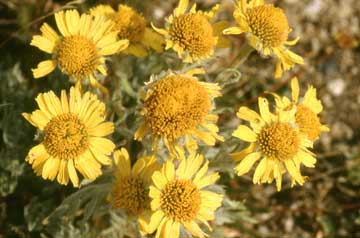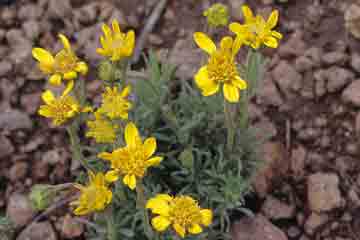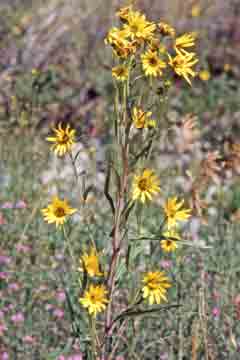
Hymenoxys, Old-man-of-mountain, Hymenoxys grandiflora (Torr. & A. Gray) K. F. Parker (left and right). The hymenoxys (sometimes classified as Tetraneuria grandiflora) is a true survivor. Its stems and leaves are covered with dense hair, reflected in the common name, "old-man-of-the mountain." This enables it to conserve metabolic heat, for temperatures may go below freezing in early summer when it flowers. By remaining "prostrate" they are protected from wind and take advantage of the retained heat of the day. (The other plants in the image on the left, growing at ground level ,are spreading phlox, Phlox diffusa, and Artemisia tridentata, the common sage.)


Stemless hymenoxys, Hymenoxys acaulis (Pursh) Greene (left). The stemless hymenoxys is less well known than its alpine relative, although the flowerheads, one to a stem, with large central disks, suggest a kinship. Its rays are wide and their number varies; occasionally the plants are rayless. A mountain plant, it prefers rocky ground, growing as high as treeline. It too is sometimes classified as a Tetraneuria.
The Alpine Hulsea, Hulsea algida A. Gray, like the hymenoxys above—has adapted to living at and above treeline. It grows in protected warm crevices on talus slope, usually flowering late in the summer. Hulseas have thick, sticky, serrated leaves that give off an aromatic odor. Yellow flowerheads are borne on thick stems. The plants are named for US Army physician, Dr. G.W. Hulse; algida means “cold” in Latin, reflecting the plants' alpine environment.


Nuttall’s sunflower, Helianthus nuttallii Torr. & A. Gray (right). The genus Helianthus is a large one, made up of sixty-seven species; several grow in Idaho. Nuttall’s sunflower is a fairly common, tall, perennial plant characterized by sunflower-like flowerheads and narrow, lanceolate, mostly opposed leaves. The plants prefer moist or recently moist soil, and grow to fairly high elevations in our mountains.


Black-hairy prairie dandelion, Nothocalaïs nigrescens (L. H. Hend.) A. Heller (right). The prairie dandelion, the mountain dandelions, hawkweeds, and several other yellow-rayed plants have common characterics: milky juice, taproots, dandelion-like pappuses, and lack diskflowers. Despite this plant’s name, “prairie-dandelion,” it is a mountain plant that grows only near the common borders of Wyoming, Montana and Idaho. The Latin species name, nigrescens, means “turning black,” for dark markings on the involucral bracts, the pointed leaves that cup the flower parts.
